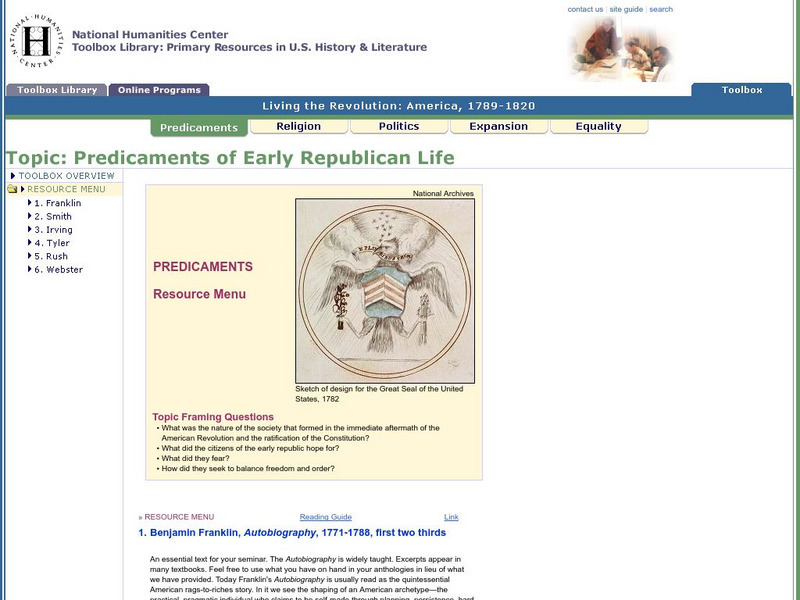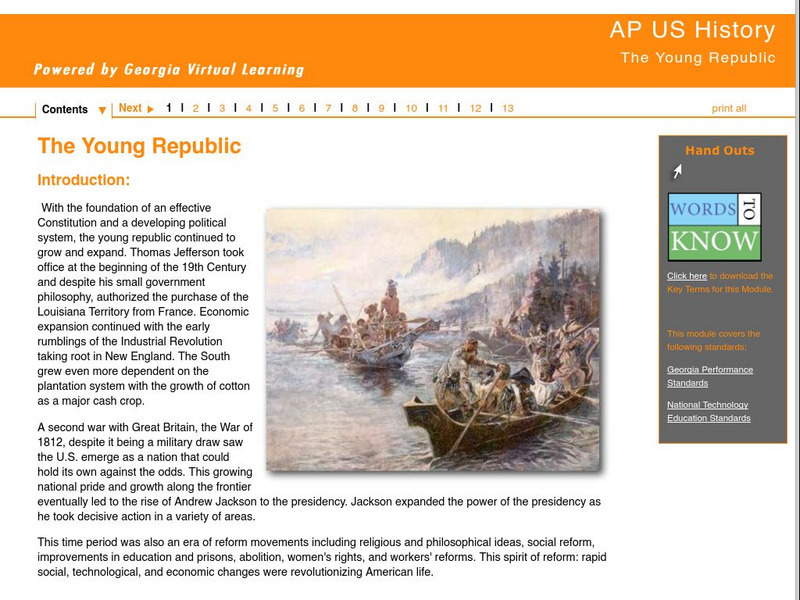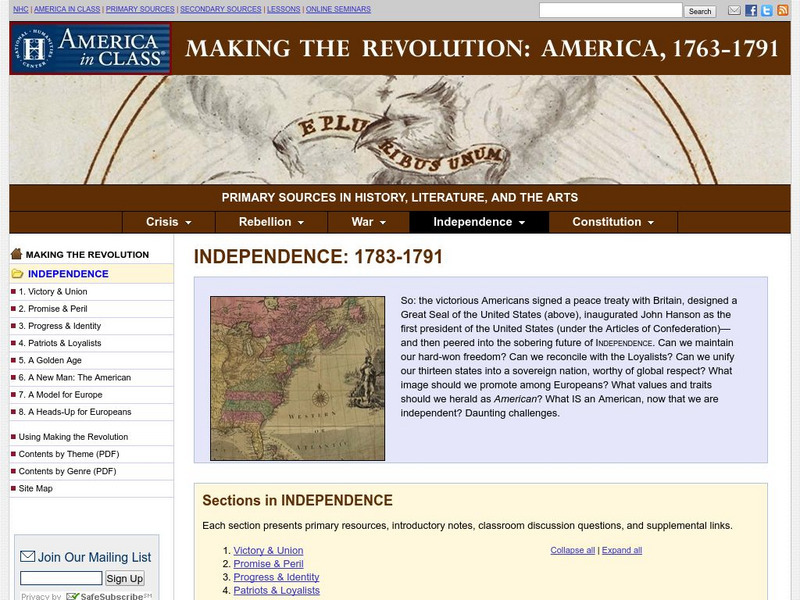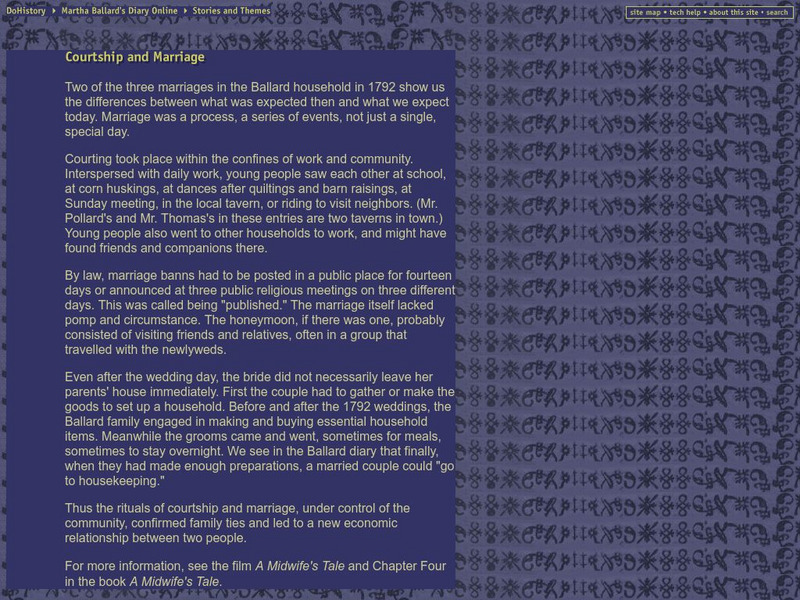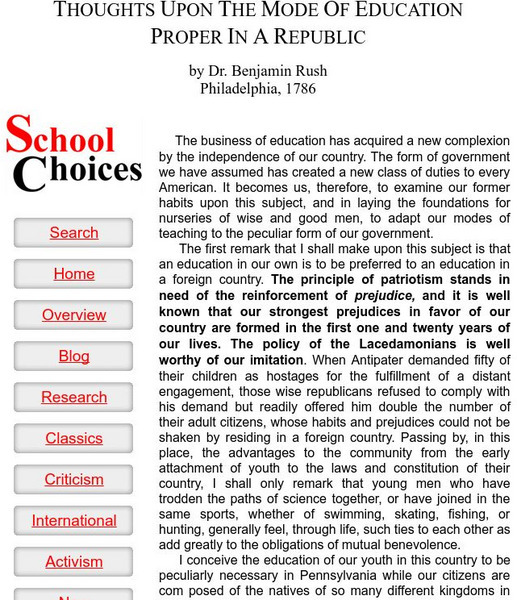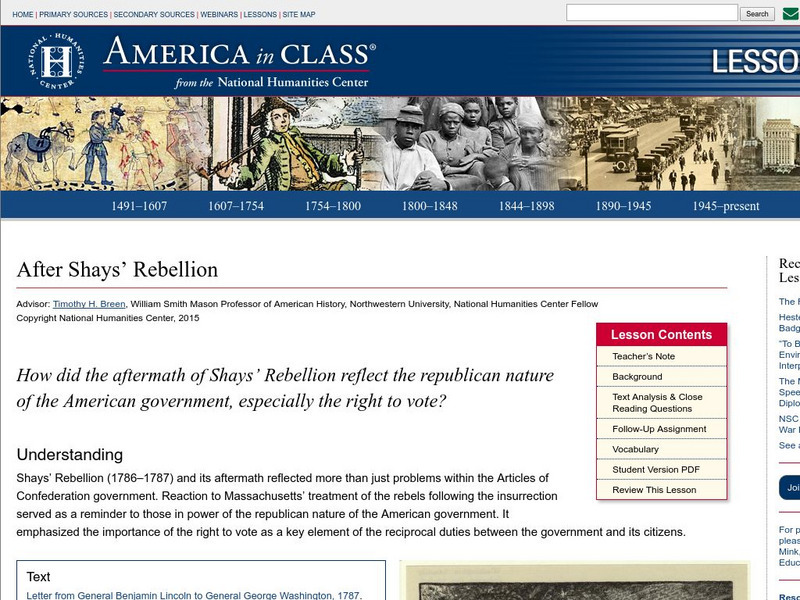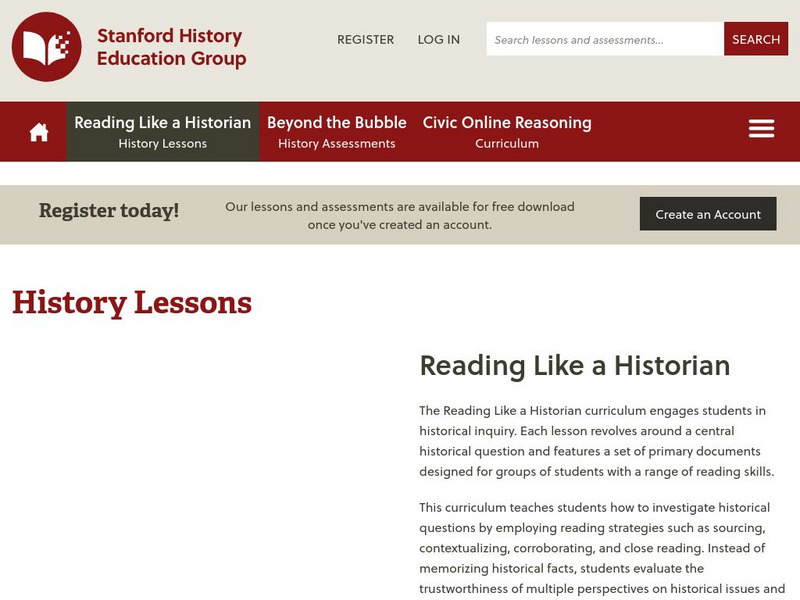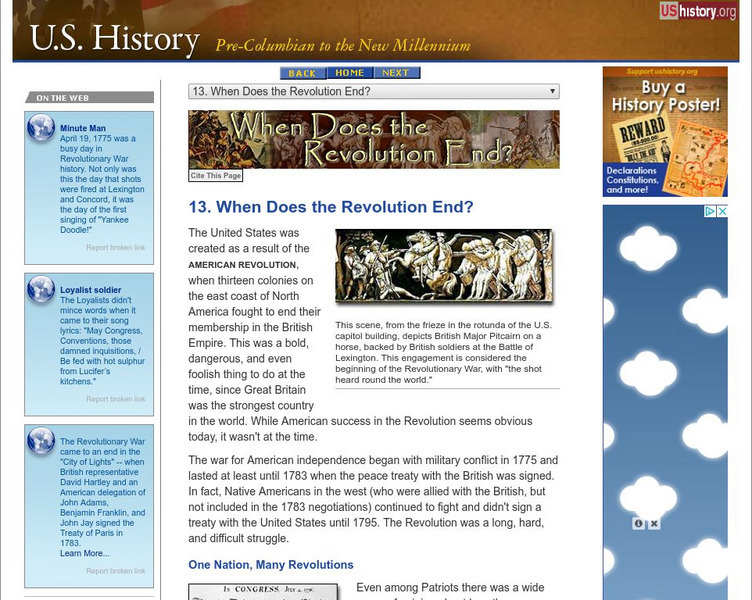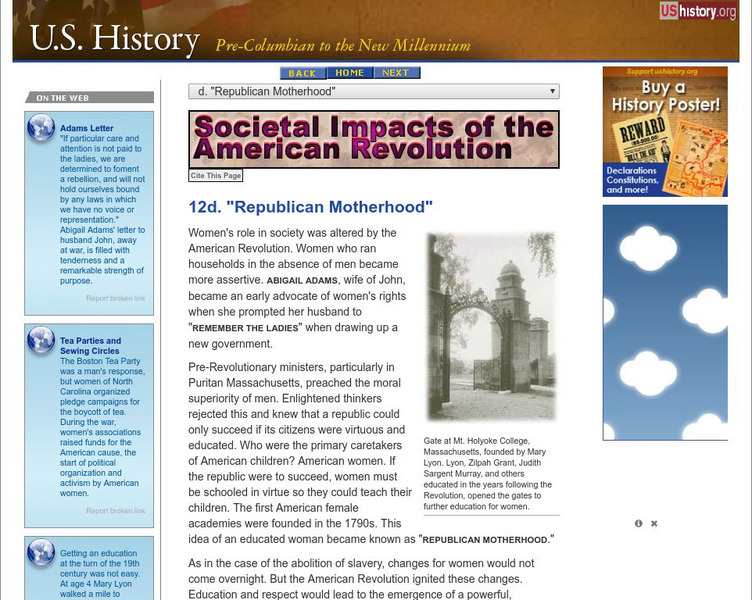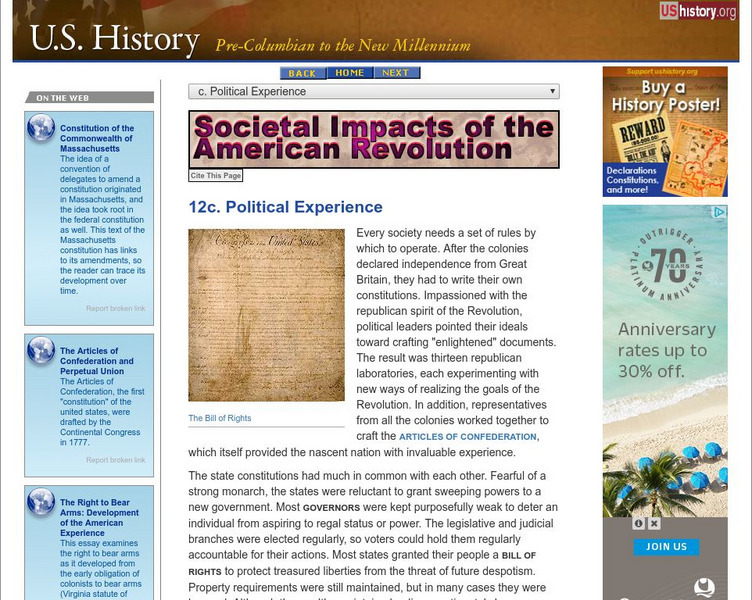National Humanities Center
National Humanities Center: Toolbox Library: Predicaments of Early Republican Life
Primary resource material focusses on predicaments in early American history. Students read primary source text to answer questions surrounding the nature of society following the American Revolution, learning about the hopes and fears...
Gilder Lehrman Institute of American History
Gilder Lehrman Institute: Ap Us History Study Guide, Period Three: 1754 1800
[Free Registration/Login Required] Comprehensive learning module for AP U.S. History on the imperial struggle over control of the American colonies, the emergence of a new republic, and the developing social, political and economic...
Georgia Department of Education
Ga Virtual Learning: Ap Us History: The Young Republic
AP U.S. History course module explores the young republic and an emerging new nation. Comprehensive multi-media learning materials.
National Humanities Center
National Humanities Center: America in Class: Making the Revolution: Independence: 1783 1791
A collection of eight primary resources with introductory notes, classroom discussion questions, and supplemental links on the period following the Revolutionary War, 1783-1791 and the making of a new nation.
Other
George Mason University: Papers of the War Department
In 1800, a fire destroyed the War Department office causing the loss of many important papers. Recently, copies of the files have been located in archives around the country and are available here as a searchable digital database.
Other
Mary Ballard's Diary on Line: Courtship and Marriage
A look at courtship and marriage in the period right after the Revolutionary War through the diary of Mary Ballard. Contains a brief explanation of courtship in this period and sections of the diary related to the topic.
Other
School Choices: Thoughts Upon the Mode of Education Proper in a Republic
Written in 1786 by famous Philadelphia physician, Benjamin Rush, this article outlines some of the goals of education in the time of the new republic.
National Humanities Center
National Humanities Center: America in Class: After Shays' Rebellion
Lesson on the aftermath of Shays' Rebellion as a reflection of the republican nature of American government and the right to vote. Includes primary resources with background information and strategies for analysis.
Annenberg Foundation
Annenberg Learner: A Biography of America: A New System of Government 1776 1826
This module examines America's efforts to form a new government after the War for Independence and to draft the Constitution. Includes an interactive activity comparing Thomas Jefferson's and Alexander Hamilton's visions for America, a...
OpenStax
Open Stax: The New American Republic
From a chapter on the New American Republic. After reading this section, students will be able to identify the major foreign and domestic uprisings of the early 1790s and explain the effect of these uprisings on the political system of...
Gilder Lehrman Institute of American History
Gilder Lehrman Institute: The New Nation, 1783 1815
[Free Registration/Login Required] This website documents the United States through its struggles to become a new nation. Site includes primary source documents for the Articles of Confederation, US Constitutional Convention, and George...
Stanford University
Sheg: Document Based History: Reading Like a Historian: Early America
[Free Registration/Login Required] The Revolution and Early America unit covers the standard eighteenth century topics that would appear in any textbook. These lessons, however, will push students to dig deeper as they read the documents...
Other
Do History: Martha Ballard's Diary Online
This site invites viewers "to piece together the life and world of an "ordinary" person from the past." The site boasts thousands of original documents that include diaries, maps, letters, and court records of a midwife from...
University of Groningen
American History: Outlines: The Significance of the American Revolution
Overiview of the Republican ideals emerging in a new nation following the American Revolution.
The History Place
The History Place: A New Nation (1784 to 1790)
This site from The History Place provides a timeline of American history between 1784 and 1790. Mentions many famous people and events of the era. Links to John Adams, Thomas Jefferson, Samuel Adams, James Madison, the Constitution, Bill...
History Tools
History Tools: Thomas Jefferson Articulates the Agrarian Ideology [Pdf]
Excerpt from Notes on the State of Virginia written by Thomas Jefferson, 1784. In this section, entitled, "Manufactures" Jefferson argues the U.S. should focus on an agrarian economy rather than manufacturing. Paragraph breaks and...
Independence Hall Association
U.s. History: Revolutionary Changes and Limitations: Women
Often the ideal and reality do not conincide for quite some time. That's true of the ideal of true equality between the sexes after the War for Independence. See why the end of the war did not bring indepence for married women, and why...
Independence Hall Association
U.s. History: When Does the Revolution End?
An interesting discussion of the precepts of the Declaration of Independence which claimed that all men were created equal, but still allowed slavery. See what the document had to say about people's rights and "the consent of the governed."
Independence Hall Association
U.s. History: "Republican Motherhood"
Although brief, this article makes clear the change in the role and perception of women in the new United States. See why it was deemed important for women to have the chance to be educated.
Independence Hall Association
U.s. History: Political Experience
Read about how the state governments in the new American nation served as the laboratory to try out new ideas of governing and treating citizens. See how remarkably similar the ideas put forth in state constitutions were to each other.
Independence Hall Association
U.s. History: Societal Impacts of the American Revolution
A look at how the ideals of the American Revolution shaped the new American Republic. Many ideals were not implemented immediately but the seed had been planted.
Smithsonian Institution
National Postal Museum: Letter Writing in America
Article from the National Postal Museum on letter writing in America and how it became important as a tie between people exploring or settling in the new world and the sponsors or loved ones they left behind. With primary source material.
Library of Congress
Loc: The New Nation, 1783 1815
The links in the New Nation, which is provided for by the Library of Congress, will lead you to sets of selected primary sources on a variety of topics,such as the Constitution, governmental policy on Native Americans, and problems and...
Independence Hall Association
U.s. History: Revolutionary Achievement: Yeomen and Artisans
Perhaps the most revolutionary result of the American Revolution was the rise in importance in politics of the moderately wealthy artisans and yeomen. Read about why this was such an amazing change in the make-up of those involved in...


